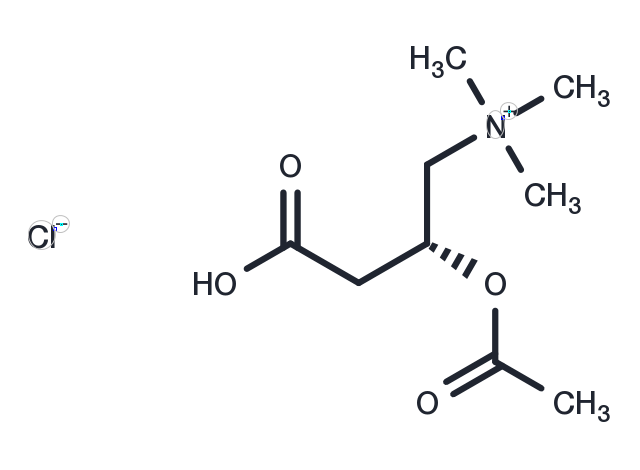Powder: -20°C for 3 years | In solvent: -80°C for 1 year


Acetyl-L-carnitine hydrochloride (Acetyl L-carnitine hydrochloride) is a nutritional supplement composed of the hydrochloride salt form of the acetylated form of the endogenously produced L-carnitine, with potential neuroprotective, cognitive-enhancing, anti-depressive and immunomodulating activities. It may also relieve peripheral neuropathy induced by chemotherapy, diabetes or other diseases. In addition, acetyl-L-carnitine may modulate the immune response by increasing T-lymphocytes maturation and may downregulate pro-inflammatory cytokines in response to viruses, such as SARS-CoV-2. It may also disrupt the ACE2 signaling pathway and inhibit the production of reactive oxygen species (ROS).

| Pack Size | Availability | Price/USD | Quantity |
|---|---|---|---|
| 10 mg | In stock | $ 36.00 | |
| 25 mg | In stock | $ 58.00 | |
| 50 mg | In stock | $ 84.00 | |
| 100 mg | In stock | $ 112.00 | |
| 200 mg | In stock | $ 143.00 | |
| 500 mg | In stock | $ 243.00 | |
| 1 mL * 10 mM (in DMSO) | In stock | $ 94.00 |



| Description | Acetyl-L-carnitine hydrochloride (Acetyl L-carnitine hydrochloride) is a nutritional supplement composed of the hydrochloride salt form of the acetylated form of the endogenously produced L-carnitine, with potential neuroprotective, cognitive-enhancing, anti-depressive and immunomodulating activities. It may also relieve peripheral neuropathy induced by chemotherapy, diabetes or other diseases. In addition, acetyl-L-carnitine may modulate the immune response by increasing T-lymphocytes maturation and may downregulate pro-inflammatory cytokines in response to viruses, such as SARS-CoV-2. It may also disrupt the ACE2 signaling pathway and inhibit the production of reactive oxygen species (ROS). |
| Synonyms | Acetyl L-carnitine hydrochloride, O-Acetylcarnitine, O-acetyl-L-carnitine, O-Acetyl-L-carnitine hydrochloride |
| Molecular Weight | 239.7 |
| Formula | C9H18ClNO4 |
| CAS No. | 5080-50-2 |
Powder: -20°C for 3 years | In solvent: -80°C for 1 year
DMSO: 30 mg/mL (125.16 mM)
You can also refer to dose conversion for different animals. More
bottom
Please see Inhibitor Handling Instructions for more frequently ask questions. Topics include: how to prepare stock solutions, how to store products, and cautions on cell-based assays & animal experiments, etc.
Acetyl-L-carnitine hydrochloride 5080-50-2 Metabolism Others Endogenous Metabolite Inhibitor ALCAR inhibit Acetyl L-carnitine hydrochloride O-Acetylcarnitine O-Acetyl-L-carnitine Hydrochloride O-acetyl-L-carnitine Acetyl-L-carnitine Hydrochloride AcetylLcarnitine hydrochloride Acetyl L-carnitine Hydrochloride Acetyl L carnitine hydrochloride O-Acetyl-L-carnitine hydrochloride inhibitor
